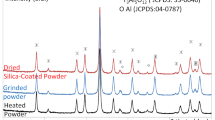Abstract
Manufacturing of glasses by shaping of powders and sintering comprises several advantages, like near-shaping of complex structures. Furthermore, sintering to fully transparent glasses is typically obtained at temperatures significantly lower than via melt fabrication. Thus incorporation of functional dopants with lower decomposition stability becomes possible, significantly increasing the variety of possible doping materials and applications. However, nanosized particles with their significantly enhanced sintering activity have to be used for powder manufacturing of glasses to avoid crystallisation. Unfortunately, no suitable nanopowders with appropriate composition are commercially available, and the manufacturing techniques proposed so far are complicated and time-consuming, often resulting in inhomogeneous doping. In contrast, by means of the newly developed reactive electrophoretic deposition (EPD) fast shaping and doping of glasses in only one process step is possible, using pure nanosized fumed silica powders as starting material. Doping is achieved by electrophoretic co-deposition of the nanoparticles and functional ions, surrounding each particle homogeneously in the electrochemical double layer. Thus doping with anions as well with cations was possible, resulting in different colouration of the silica glass (blue or gold ruby), with the coefficient of absorption being a function of the ion concentration within the suspension. Furthermore, a decrease in sintering temperature was achieved by EPR with boric acid. Finally, co-doping with anions and cations resulted in the manufacturing of multicomponent glasses with a decrease in sintering temperature of 450 °C compared to pure silica OX50.







Similar content being viewed by others
References
Alekseyenko MP (1970) Sov J Opt Technol 37:528
Rabinovich EM (1985) J Mater Sci 20:4259
Smeets K, Clasen R (2002) In: Lin H-T, Singh M (eds) Proceedings of the 26th Annual Conference on Composites, Advanced Ceramics, Materials and Structures, Cocoa Beach, Florida, USA. The American Ceramic Society, Westerville, p 593
Tabellion J, Clasen R (2002) Ceram Eng Sci Proc 23:617
Tabellion J, Clasen R (2003) Ceram Eng Sci Proc 24
Carman PC (1956) In: Flow of gases through porous media. Butterworth Sci. Pub., London, p 21
Smeets K, Clasen R (2002) Key Eng Mater 206–213:2113
Fenske K (1995) Herstellung und Charakterisierung farbiger Kieselgläser (Manufacturing and characterization of coloured silica glasses), PhD-Thesis, Saarland University
Oetzel C, Clasen R, Tabellion J (2004) cfi 81:E35
Smeets K, Tabellion J, Clasen R (2002) In: Lin H-T, Singh M (eds) Proceedings of the 26th Annual Conference on Composites, Advanced Ceramics, Materials and Structures, Cocoa Beach, Florida, USA. The American Ceramic Society, City, p 629
Matsuyama I, Susa K, Satoh S, Suganuma T (1984) Am Ceram Soc Bull 63:1408
Rabinovich EM, Nassau K, Miller AE, Gallagher PK (1988) J Non-Cryst Solids 104:107
Clasen R (1989) Herstellung sehr reiner Kieselgläser durch Sintern submikroskopischer Glasteilchen (Manufacturing of ultra-pure silica glasses by sintering of submicron glass particles), University of Aachen
Boccaccini AR, Zhitomirsky I (2002) Curr Opin Solid St M 6:251
Put S, Vleugels J, Anné G, Biest Ovd (2003) Colloids Surf A 222:223
Ferrari B, González S, Moreno R, Baudín C (2006) J Eur Cer Soc 26:27
Boccaccini AR, Kaya C, Chawla KK (2002) Compos Part A 32:125
Chen YH, Ma J, Li T (2004) Ceram Int 30:683
Tabellion J, Clasen R (2004) J Mater Sci 39:803
Biest OOVd, Vandeperre LJ (1999) Annu Rev Mater Sci 29:327
Nicholson PS, Fukada Y, Nagarajan N, Mekky W, Bao Y, Kim H-S (2004) J Mater Sci 39:787
Clasen R (1988) In: Hausner H, Messing GL, Hirano S (eds) Proceedings of 2nd Int. Conf. on Powder Processing Science, Berchtesgaden. Deutsche Keramische Gesellschaft, Köln, p 633
Tabellion J, Clasen R (2000) In: Innovative Processing and Synthesis of Ceramics, Glasses, and Composites IV. Am. Ceram. Soc., Westerville, p 185
Author information
Authors and Affiliations
Corresponding author
Rights and permissions
About this article
Cite this article
Tabellion, J., Zeiner, J. & Clasen, R. Manufacturing of pure and doped silica and multicomponent glasses from SiO2 nanoparticles by reactive electrophoretic deposition. J Mater Sci 41, 8173–8180 (2006). https://doi.org/10.1007/s10853-006-0599-1
Received:
Accepted:
Published:
Issue Date:
DOI: https://doi.org/10.1007/s10853-006-0599-1




